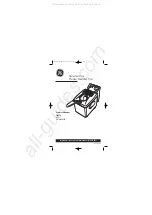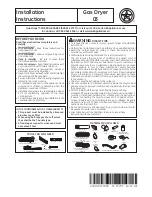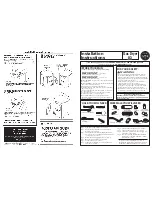
Thank you for purchasing a Sealey product. Manufactured to a high standard, this product will, if used according to these instructions,
and properly maintained, give you years of trouble free performance.
IMPORTANT:
PLEASE READ THESE INSTRUCTIONS CAREFULLY. NOTE THE SAFE OPERATIONAL REQUIREMENTS, WARNINGS & CAUTIONS. USE
THE PRODUCT CORRECTLY AND WITH CARE FOR THE PURPOSE FOR WHICH IT IS INTENDED. FAILURE TO DO SO MAY CAUSE DAMAGE AND/OR
PERSONAL INJURY AND WILL INVALIDATE THE WARRANTY. KEEP THESE INSTRUCTIONS SAFE FOR FUTURE USE.
1. SAFETY
1.1. Electrical Safety
WARNING! It is the owner’s responsibility to read, understand and comply with the following:
You must check all electrical equipment and appliances to ensure that they are safe before use. You must inspect power supply leads, plugs and
all electrical connections for wear and damage. You must ensure the risk of electric shock is minimised by the installation of appropriate safety
devices. An RCCB (Residual Current Circuit Breaker) should be incorporated in the main distribution board. We also recommend that an RCD
(Residual Current Device) is used with all electrical products. It is particularly important to use an RCD with portable products that are plugged into
an electrical supply not protected by an RCCB. If in doubt consult a qualified electrician. You may obtain a Residual Current Device by contacting
your Sealey dealer.
You must
also read and understand the following instructions concerning electrical safety.
1.1.1. The
Electricity At Work Act 1989
requires all portable electrical appliances, if used on business premises, to be tested by
a qualified electrician, using a Portable Appliance Tester (PAT), at least once a year.
1.1.2. The
Health & Safety at Work Act 1974
makes owners of electrical appliances responsible for the safe condition of the appliance
and the safety of the appliance operator.
If in any doubt about electrical safety, contact a qualified electrician.
1.1.3. Ensure the insulation on all cables and the product itself is safe before connecting to the mains power supply. See 1.1.1. & 1.1.2. above
and use a Portable Appliance Tester (PAT).
1.1.4. Ensure that cables are always protected against short circuit and overload.
1.1.5. Regularly inspect power supply, leads, plugs for wear and damage and all electrical connections
to ensure that none is loose.
1.1.6.
Important:
Ensure the voltage marked on the product is the same as the electrical power supply
to be used and check that supply is correctly fused, see fuse rating at right.
1.1.7.
DO NOT
pull or carry the powered appliance by its power supply lead.
1.1.8.
DO NOT
pull power plugs from sockets by the power cable.
1.1.9.
DO NOT
use worn or damaged leads, plugs or connections. Immediately replace or have repaired
by a qualified electrician.
1.1.10. This product comes without a plug.
You must
contact a qualified electrician to ensure an adequate
supply is available.
If fitting such a plug -
Ensure that the unit is correctly wired and earthed, as follows:
a) Connect the GREEN/YELLOW earth wire to the earth terminal ‘E’.
b) Connect the BROWN live wire to live terminal ‘L’.
c) Connect the BLUE neutral wire to the neutral terminal ‘N’.
d) After wiring, check there are no bare wires, that all wires have been correctly connected,
that the cable outer insulation is clamped by the cable grip and that the grip is tight.
1.1.11.
Cable extension reels
. When a cable extension reel is used it should be fully unwound before connection. A cable reel with an RCD
fitted is recommended since any product which is plugged into the cable reel will be protected. The section of the cores of the cable is
important. 2.5mm² section is a minimum, but to be absolutely sure that the capacity of the cable reel is suitable for this product and
for others that may be used in the other output sockets, we recommend the use of 2.5mm² section cable.
1.2.
General Safety
WARNING! Ensure there is nobody in front of the lamp when it is switched on.
9
Disconnect the panel dryer from the power supply before servicing, changing accessories, or performing any maintenance.
9
Ensure that the panel dryer is in good condition before use. If in any doubt do not use the unit and contact an electrician.
9
Familiarise yourself with the application and limitations of the panel dryer.
9
Check that lamp guards are in place, undamaged and firmly attached.
9
Keep tools and other items away from the panel dryer when it is in use.
9
Keep the work area clean and clear of unnecessary items.
9
Remember that the lamp panel will get hot, allow to cool after use.
9
Maintain the panel dryer in good condition. Use authorised agent for servicing.
9
Keep the dryer clean, but
DO NOT
use solvents.
9
Use only genuine parts and accessories.
Unauthorised parts and accessories may be dangerous and will invalidate your
warranty.
8
DO NOT
use this product to perform a task for which it has not been designed.
8
DO NOT
use the panel dryer outdoors, or in damp, or wet locations, and
DO NOT
operate within the vicinity of flammable liquids, gases or
solids.
WARNING! Never use in explosive situations.
Indoor
Use Only
IR3000.V2| Issue 1 06/09/16
Original Language Version
© Jack Sealey Limited
INSTRUCTIONS FOR:
SHORT WAVE INFRARED PANEL DRYER
MODEL NO:
IR3000.V2
Refer to
Instruction
Manual
Warning:
Electricity
Warning:
Hot Surface
THIS PRODUCT REQUIRES A
MINIMUM 16 AMP
SUPPLY
























